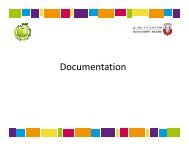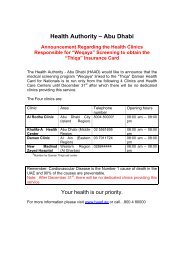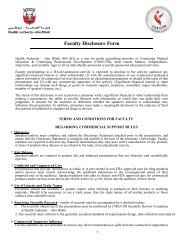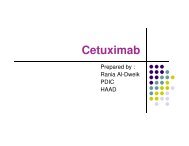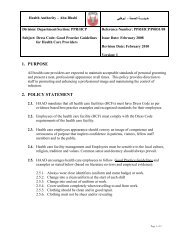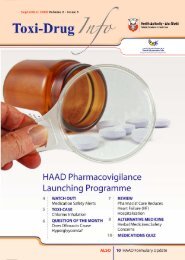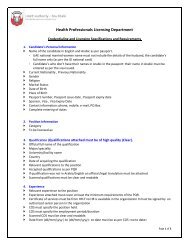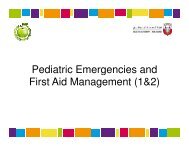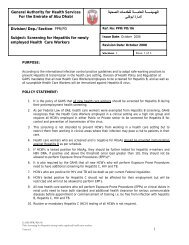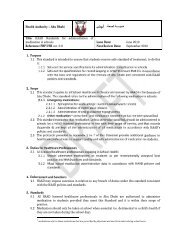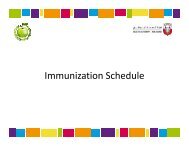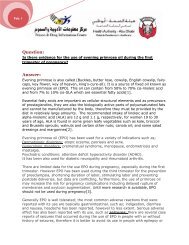HAAD Standards For Licensure And Quality Improvement
HAAD Standards For Licensure And Quality Improvement
HAAD Standards For Licensure And Quality Improvement
- No tags were found...
You also want an ePaper? Increase the reach of your titles
YUMPU automatically turns print PDFs into web optimized ePapers that Google loves.
<strong>HAAD</strong> <strong>Standards</strong>for<strong>Licensure</strong> and <strong>Quality</strong><strong>Improvement</strong>Dr. David MatearProject Manager
Agenda1. Background to the <strong>HAAD</strong> <strong>Standards</strong> project2. <strong>HAAD</strong>‐JCI <strong>Standards</strong>3. Hospital <strong>Standards</strong>4. Major standards chapters5. Identified problems6. Relevant standards• Patient Safety and <strong>Quality</strong> <strong>Improvement</strong> (PCQ)• Communication (CCC)• High Risk Care Processes (HRC)• Leadership (LDS)7. Summary
HSRC Terms of ReferenceAdministrative Decision No.26/2007Administrative decision• Membership from <strong>HAAD</strong>, Health Services Company andmanagement organizations• Goal ‐ Review, amendment, and recommendation ofstandards for licensure and inspection of health facilities inthe Emirate of Abu Dhabi.• Objectives– Review draft standards submitted by JCI in the areas of Hospital,Ambulatory Care, and Continuum of Care.– Consider other developing and related standards.– Propose amendments to the proposed standards.– Recommend the adoption of standards that are consistent withinternational standards.– Develop a mechanism for annual standards review.
Major <strong>Standards</strong> Chapters• Patient Safety and <strong>Quality</strong><strong>Improvement</strong>• Communication• High risk care processes• Leadership• Facility Safety
Mandatory <strong>Standards</strong>• Represent the most important• Based on law, regulatory policies• Selected critical Measurable Elements (MEs)or standards• MUST be met for licensure
Problems Identified• Patient safety• Communication• Provision of high risk care• Referrals and transfers• Documentation• Professional qualifications and skills
General Principles• Ensure the clinical and other professional qualifications of allstaff according to <strong>HAAD</strong> licensing policies– Expectations of international good practice– Maintain safety• Ensure their facilities and equipment are sufficient– deliver safe, high‐quality care in accordance with international goodpractice.• Ensure there are robust clinical and management processesfor the tracking of patient safety and the effectiveness oftreatment, including accurate, fit‐for‐purpose clinical records.• Report any occurrence that results in a risk to patient safetyor compromises the delivery of high‐quality care
Patient Safety Goals• All 6 Patient Safety Goals are MANDATORY• Relevant other standards• PCQ.1 Goal 1 – Identify patients correctly– ME 5 Before treatment or procedures• PCQ.2 Goal 2 –Improve effectivecommunication
Monitoring Requirements• PCQ.8 –Monitoring of Patient Safety Goals• PCQ.13 – Identification of key measures to monitor– ME 5 –Patient assessment– ME 13 – Availability, timeliness, content, and use ofpatient records– ME 16 –Reporting of activities as required by law andregulation– ME 17 –Risk management– ME 23 –Prevention and control of events that jeopardizethe safety of patients, families, and staff
Investigation and Reporting of Events• PCQ.17 –The hospital uses a defined processfor identifying and managing sentinel events– Definition of events to be investigated– Root cause analysis within 45 days– Change procedures• PCQ.18 –Data are analyzed whenundesirable trends and variation areidentified
CommunicationAdmission• CCC.1 –Patients are admitted to receive inpatient carebased on their identified health care needs and thehospital’s mission and resources.– ME 1 – Screening is initiated at the point of first contact within oroutside the hospital.• CCC.3 –Patients with emergency or immediate needs aregiven priority for assessment and treatment.– ME 1 –The hospital has established criteria to prioritize patientswith immediate needs.• CCC.6 – Admission or transfer to or from units providingintensive or specialized services is determined byestablished criteria.– ME 1 –The hospital has established entry and/or transfer criteria forits intensive and specialized services or units.– ME 5 –Patients transferred or admitted to intensive and specializedunits/services meet the criteria and this is documented in thepatient’s record.
Discharge, Referral, Follow‐up• CCC.8 –There is a policy guiding the appropriatereferral or discharge of patients– ME 1 –There is a policy guiding the appropriate referraland/or discharge of patients– ME 2 –The referral and/or discharge is based on thepatient’s needs for continuing care• CCC.9 – Patient records contain a copy of thedischarge summary– ME 4 –A copy of the discharge summary is provided tothe practitioner responsible for the patient’s continuingor follow‐up care
Transfer of Patients• CCC.10 –There is a policy guiding the appropriate transfer ofpatients to another hospital or organization to meet theircontinuing care needs– ME 2 –The process addresses the transfer of responsibility toanother provider or setting– ME 5 –The process addresses who is responsible during transfer– ME 7 –Patients are appropriately transferred to other hospitals ororganizations• CCC.11 ‐ The referring hospital organization determines thatthe receiving hospital can meet the patient’s continuing careneeds– ME 1 –The referring hospital determines that the receiving hospitalcan meet the needs of the patient to be transferred– ME 2 –Patient clinical information or a clinical summary istransferred with the patient
Transfer of Patients• CCC.12 –During direct transfer, a qualified staff membermonitors the patient’s condition– ME 1 – All patients are monitored during direct transfer to anotherhospital• CCC.13 –The transfer process is documented in the patient’srecord– ME 1 –The records of transferred patients note the name of thehospital and name of the individual agreeing to receive the patient– ME 2 –The records of transferred patients note the reason(s) fortransfer– ME 3 –The records of transferred patients note any specialconditions related to transfer– ME 4 –The records of transferred patients note any change ofpatient condition or status during transfer
Transportation• CCC.14 –The process for referring,transferring, or discharging the patientconsiders transportation needs– ME 1 –The process for referring patientsconsiders transportation needs– ME 4 –Transportation is appropriate to thepatient’s needs
High Risk CareAssessments and Care• HRC 11 – Qualified individuals conduct theassessments and reassessments– ME 2 –Only those individuals permitted by licensure,applicable laws and regulations, or certification performpatient assessments– ME 3 – Emergency assessments are conducted byindividuals qualified to do so• HRC 16 – Policies and procedures guide the care ofhigh‐risk patients and the provision of high‐riskservices– ME 1 –(a) Care of emergency patients
LeadershipEthics• LDS.3 –The hospital establishes a framework forethical management that ensures that patient careis provided within business, financial, ethical, andlegal norms and that protects patients and theirrights– ME 4 –The hospital provides clear admission, transfer, anddischarge policies– ME 6 –The hospital discloses and resolves conflicts whenfinancial incentives and payment arrangementscompromise patient care
Departmental Leadership• LDS.8 –One or more qualified individualsprovide direction for each department orservice in the hospital– ME 1 –An individual with appropriate training, education,and experience directs each department or service in thehospital
Staff Education• LDS.17 –Staff members who provide direct care and servicesand other staff identified by the hospital are annuallytrained in basic or advanced cardiac life support– ME 1 –Staff members to be trained in cardiac life supportare identified by the development of a list. The listincludes at least all direct care givers– ME 2 –The appropriate level of training is provided (e.g.,basic life support (BLS), advanced life support (ALS),pediatric advanced life support (PALS))– ME 3 –Staff members are retrained every two years– ME 4 –There is evidence to show if a staff member passedthe training which includes both a written test and returndemonstration
Medical Staffing• LDS.18 –The hospital has an effective process for gathering,verifying, and evaluating the credentials (license, education,training, and experience) of those medical staff permitted toprovide care and services to individuals without supervision– ME 1 –Those permitted by laws and regulations and bythe hospital to provide care and services to individualswithout supervision are identified– ME 2 – Current licensure, education, training, andexperience are documented for these professionals– ME 3 – Such information is verified from the originalsource
Medical Staffing• LDS.19 –The hospital maintains for every medicalstaff member a record of the current professionallicense, certificate, or registration when required bylaws or regulations or by the organization– ME 2(c) – Current list of privileges• LDS.20 –The credentials of medical staff membersare reevaluated at least every 3 years to determinetheir qualifications to continue to provide care andservices in the organization– ME1 –There is a process to evaluate each medical staffmember every three years
Medical Staffing• LDS.21 –The hospital has a standardized, objective,evidence‐based procedure to authorize all medicalstaff members to admit and treat patients andprovide other clinical services consistent with theirqualifications– ME 1 –There is a standardized procedure to grantprivileges to practitioners on initial appointment and onreappointment every three years– ME 5 –The aggregation of the annual data is used in theevaluation for reappointment which occurs every threeyears
Summary• Approved licensing standards govern health care• Mandatory standards must be met• The problems identified are covered in the standards– Patient safety– Communication– Provision of high risk care– Referrals and transfers– Documentation– Professional qualifications and skills• Relevant standards to identified problems– Patient Safety and <strong>Quality</strong> <strong>Improvement</strong> (PCQ)– Communication (CCC)– High Risk Care Processes (HRC)– Leadership (LDS)• Inspectors will enforce that standards are met
QUESTIONS?



